- Retour accueil
- Vous êtes ici : Blog The Pyramids of the Cold The Pyramids of the Cold Section 30 • Crocodile god Sobek's fishing net
The Pyramids of the Cold Section 30 • Crocodile god Sobek's fishing net
Publié par Bruno Coursol dans The Pyramids of the Cold le 20/02/2023 à 11:05
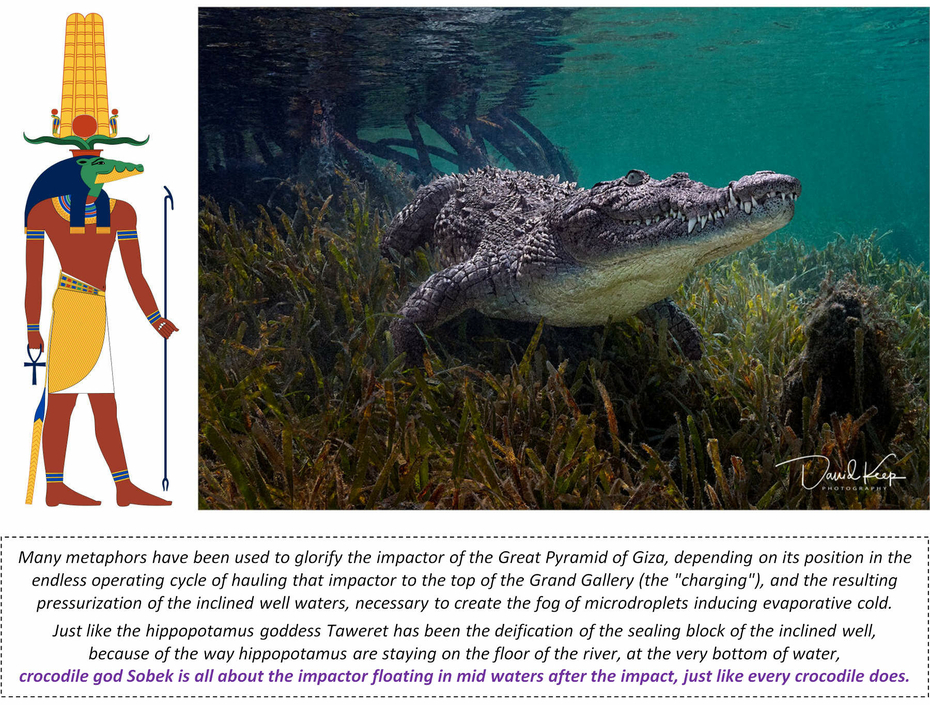
Saltwater Crocodile at Jardines de la Reina, Cuba. © David Keep: https://www.davidkeepphotography.co.uk/latestnews/tag/Crocodile
"Sobek, an ancient Egyptian crocodile god, often depicted with a crown composed of ram horns, a sun disk, and feathered plumes". Draw by Jeff Dahl: https://en.wikipedia.org/wiki/Sobek#/media/File:Sobek.svg
The Pyramids of the Cold Section 30: Crocodile god Sobek's fishing net and the Four Sons of Horus
In summary: until now, we've seen many glorifications and deifications of how was operated the Great Pyramid of Giza, and in particular the impactor descending the Grand Gallery towards the inclined well (Horus the Elder and Medjed), and painstakingly rising up in the Gallery from the well (the Bennu bird and Horus the Child) by the effort of the Hauling beetle; but one major part of the cycle was missing, and it was how the impactor had been glorified when it was inside the well.
The answer of that question is in Sobek, the crocodile god: it is known that "Sobek was sometimes considered to be an aspect of Horus because Horus took the form of a crocodile to retrieve the parts of Osiris’ body which were lost in the Nile", and in a different version of the tale of Osiris, "it was Sobek who carried the dead body of Osiris to the bank of the Nile on his back".
That last sentence is the key: if Sobek is the one "carrying the dead body of Osiris to the bank of the Nile on his back", it is because the impactor has become Sobek, carrying the Osiris weight without any energy left in him.
And because "It is said that Sobek was the god who caught the four sons of Horus in a [fishing] net", we also have the proof that the Four Sons of Horus are the glorification of the crewmembers that were inside the Hauling beetle: they would have looked like caught in a fishing net.
On the question of how many crewmembers were "caught" inside the Hauling beetle "fishing net", the fact that ancient Egyptians loved to pair up everything, could indicate that the Four Sons of Horus actually really stand for 8 crewmembers: each Son of Horus representing two crewmembers; just like the left arm and the right arm of a single man.
30.01 When the floating impactor Sobek is "carrying the body of Osiris on his back"
We've already seen in previous Sections, that Osiris was the one who gave all his force and energy to Ra, because Osiris is the deification of the stone weight that was nested inside the wooden impactor; but once in the inclined well, that weight, the Osiris stone, doesn't have any energy left: Osiris is "dead", and it would require to be hauled back up to the top of the Grand Gallery before being able to do its job, one more time.
That is what the excerpt "it was Sobek who carried the dead body of Osiris to the bank of the Nile on his back" is all about.
"In a different version of the tale of Osiris, it was Sobek who carried the dead body of Osiris to the bank of the Nile on his back. The four mummiform sons of Horus - Imsety, human headed protector of the liver, Hapy, baboon headed protector of the lungs, Duamutef, jackal headed protector of the stomach and Qebehsenuef, falcon headed protector of the intestines - were believed to have come out of a water lily that rose from the waters of Nun. Under the orders of Ra, the four gods were rescued by Sobek in a net, and brought them to land." http://www.touregypt.net/featurestories/sobeka.htm
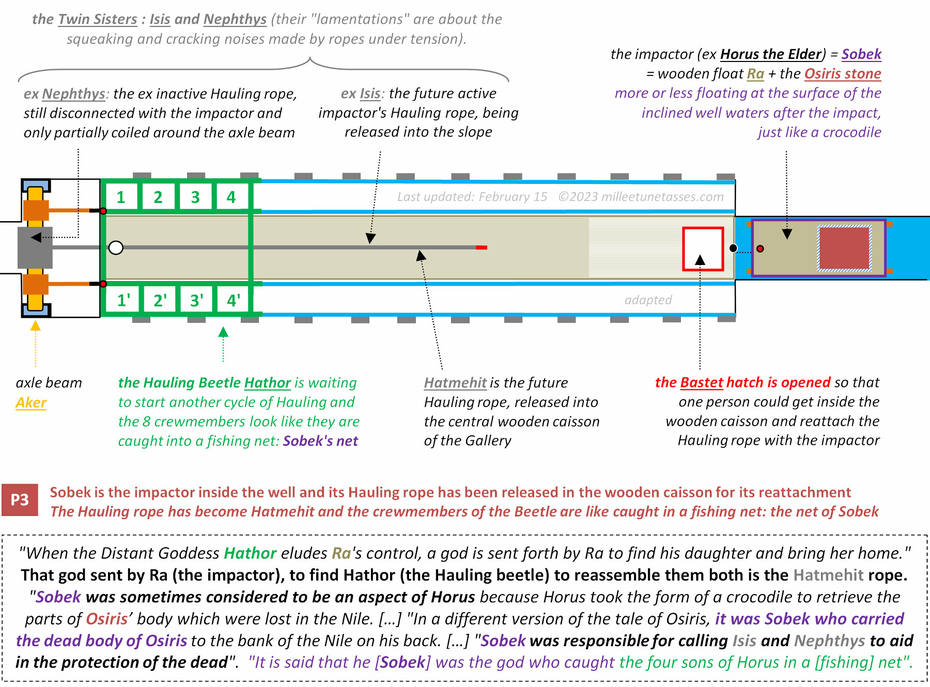
30.02 Operating diagram of the impactor of the Great Pyramid, floating inside the inclined well after the impact (P3)
The other diagrams of the entire operating cycle of the Grand Gallery (P1 to P8) are available in Section 27 • The Memphis Triad
30.03 When the impactor Ra is sending the Hatmehit rope to reconnect with the Distant Goddess Hathor Hauling beetle
For the recovery of the impactor, one man had to get inside the fixed caisson to reattach the Hatmehit rope, and start a whole new Hauling cycle towards the upper part of the Grand Gallery. The Acacia wooden caisson had to have a hatch at the bottom of the Gallery.
"When the Distant Goddess (Hathor) eludes Ra's control, a god is sent forth by Ra to find his daughter and bring her home and, when this happens, she brings with her the inundation of the Nile River which overflowed its banks […]"
The god sent by Ra (who is the impactor), to find Hathor (the Hauling beetle) to reassemble them both is precisely the Hatmehit rope.
"When the Distant Goddess eludes Ra's control, a god is sent forth by Ra to find his daughter and bring her home and, when this happens, she brings with her the inundation of the Nile River which overflowed its banks and brought life to the people". https://www.worldhistory.org/Hathor/
30.04 The perfect fishing net metaphor of the Hauling beetle crewmembers "caught" inside the beetle's wooden structure
In the following excerpts, it is also mentioned a fishing net used by Sobek to rescue the Four Sons of Horus. To understand the metaphor, you have to imagine what would have looked like the Hauling beetle, with every crewmember isolated in his own little "niche": the crewmembers of the Beetle would have looked like they were caught in a fishing net.
I know I've said that many, many times, but isn't this particular metaphor one of the best of all?
"Sobek was revered for his ferocity and quick movement. It is said that he was the god who caught the four sons of Horus in a net, as they emerged from the waters in a lotus bloom." http://www.touregypt.net/featurestories/sobek.htm
"In a different version of the tale of Osiris, it was Sobek who carried the dead body of Osiris to the bank of the Nile on his back. The four mummiform sons of Horus - Imsety, human headed protector of the liver, Hapy, baboon headed protector of the lungs, Duamutef, jackal headed protector of the stomach and Qebehsenuef, falcon headed protector of the intestines - were believed to have come out of a water lily that rose from the waters of Nun. Under the orders of Ra, the four gods were rescued by Sobek in a net, and brought them to land." http://www.touregypt.net/featurestories/sobeka.htm
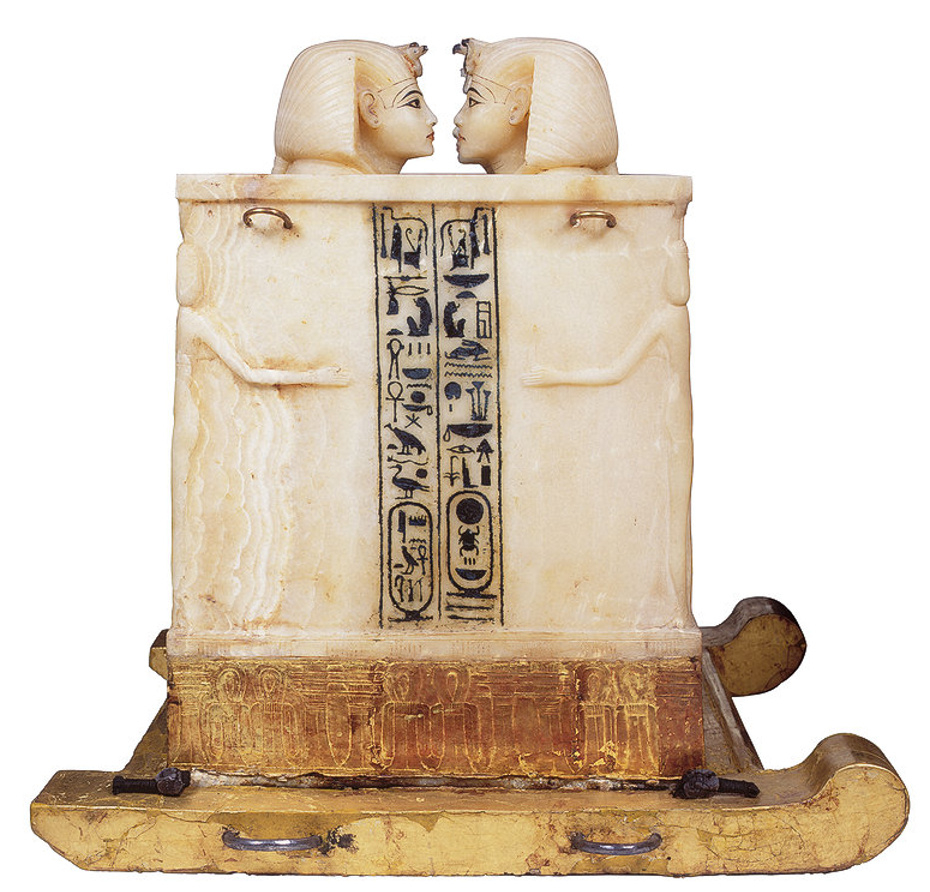
The Canopic Chest of Tutankhamun: http://www.globalegyptianmuseum.org/detail.aspx?id=15099
30.05 The representation of the crewmembers "caught" inside the Hauling beetle... on sled runners
What is incredible in the above Canopic Chest of Tutankhamun is that it is showing magnificent sled runners, just like the ones used on modern skeleton sleds (please read previous Section 29, with the representation of Osiris in the typical skeleton position).
Most probably, there were 3 sets of runners used in the Grand Gallery: one set for the impactor (but hypothetical), and two sets for the two half-beetles (as represented in the different positions of the Hauling beetle's operating cycle, P1 to P8).
Of course, the heads of the lids shouldn't face each over: they should be back to back.
"This alabaster canopic chest is considered to be one of the finest masterpieces of Tutankhamun's collection. The interior of the chest is divided into four compartments, each with a cylindrical hollow covered by a lid elegantly carved in the form of the king's head. The lid was fixed to the chest with cords knotted to gold rings and bore the official seal of the royal necropolis. Within each compartment was a miniature gold mummiform coffin that held the king's embalmed internal organs". http://www.globalegyptianmuseum.org/detail.aspx?id=15099
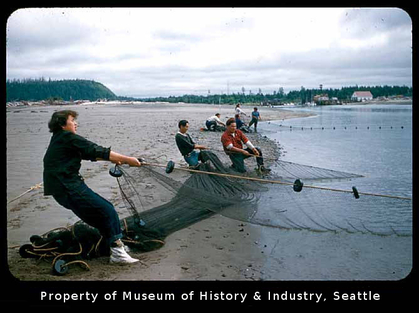
30.06 The crewmembers' posture inside the Hauling beetle
What is even more incredible in the Sobek fishing net metaphor, is that the natural posture adopted when hauling in the nets, is a perfect replica of the posture that would have to take the crewmembers of the Hauling beetle themselves: they would have to put all their weight on their backs, towards the bottom of the Gallery.
Men and women hauling a fishing net onto a beach on the Quileute Indian Reservation. Photographer: Thompson, J.W. © Museum of History & Industry, Seattle; All Rights Reserved. https://digitalcollections.lib.washington.edu/digital/collection/mohai-thompson/id/312
30.07 When Sobek is reaching for the impactor's Hauling rope by "calling Isis and Nephthys for help"
What is incredible about Sobek, is that not only we have the floating impactor Sobek, reaching for the crewmembers of the Hauling beetle by casting or throwing a fishing net, but we also have Sobek reaching for the Hauling rope itself by calling Isis and Nephthys, the deification of this particular rope, respectively the active Hauling rope (Isis) and that same exact rope but completely wound around the axle beam, and so completely inactive (Nephthys).
"Sobek was responsible for calling Isis and Nephthys to aid in the protection of the dead". http://www.touregypt.net/featurestories/sobeka.htm
30.08 When Sobek is finally ready to ascend the Grand Gallery
Now, the floating impactor Sobek has everything it needs to get back to the top of the Grand Gallery: the Hauling beetle (the fishing net), the crewmembers of the Beetle (the Four Sons of Horus who were actually four pairs), and the Hauling rope, Isis.
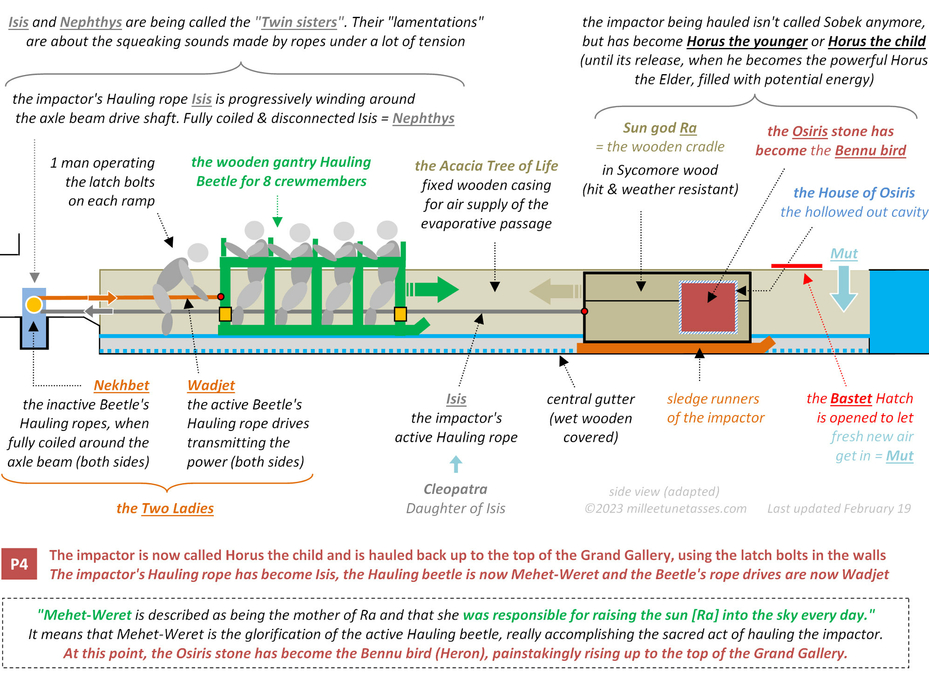
30.09 Operating diagram of the impactor of the Great Pyramid of Giza being hauled inside the Grand Gallery (P4)
The other diagrams of the entire operating cycle of the Grand Gallery (P1 to P8) are available in Section 27 • The Memphis Triad
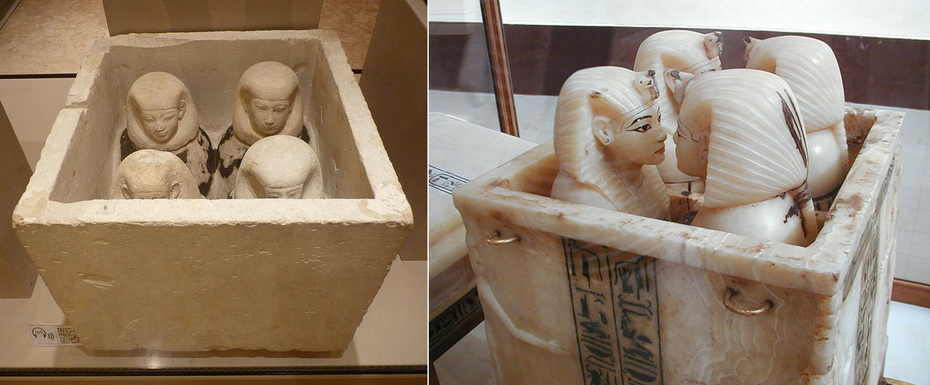
"Canopic chest with four canopic jars; chest and jars are part of the same, monolithic limestone block. Unknown provenience, 12th-13th dynasty, Middle Kingdom. Archeological Museum of Bologna (Italy), KS 3247". Photograph by Khruner: https://commons.wikimedia.org/wiki/File:Canopic_chest_01.JPG and also: http://www.museibologna.it/archeologicoen/percorsi/66288/id/74866/oggetto/74875/
"Tutankhamun's canopic chest. Egyptian Museum, Cairo. An alabaster chest with four cavities to hold the internal organs. Each is cavity is covered by a stopper carved with a portrait of Tutankhamun". Photograph by Jon Bodsworth: https://en.wikipedia.org/wiki/Canopic_chest#/media/File:Cano_ja_49_tut.jpg
30.10 Was there really 8 crewmembers "caught" inside 8 "niches"?
The question is to know if we can take literally the 4 compartments of the canopic chest of Tutankhamun, or the Four Sons of Horus in other canopic chests, keeping in mind that every of these compartments or every single Son of Horus really stands for 2 crewmembers (the left arm and the right arm, joining their efforts to indirectly haul the impactor).
For now, I will tend to think that they really were 8 crewmembers, each and every one of them "caught" in his individual wooden "niche", but I would say it is about 80% sure at best. On the draws I've made, I also had to add one crewmember on each ramp, primarily to deal with the latch bolts; but maybe this "additional" crewmember actually really is one the 8 crewmembers and there would have been only 6 niches.
Maybe we will never have a 100% certainty about this, before life-sized reconstitutions would be made of the operating of the Grand Gallery.
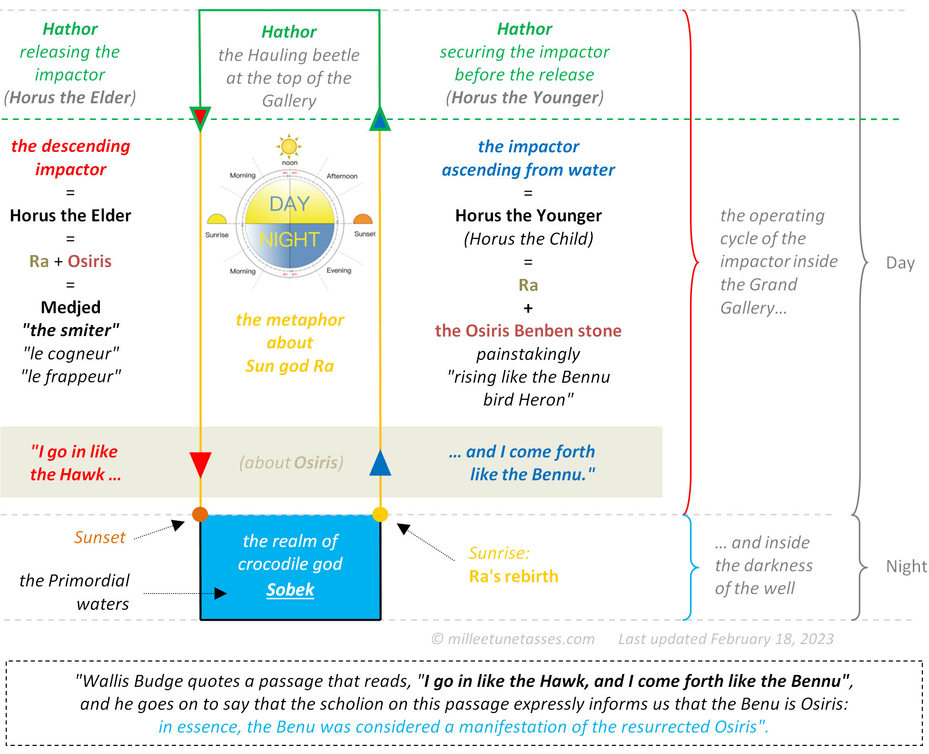
"Wallis Budge quotes a passage that reads, "I go in like the Hawk, and I come forth like the Bennu", and he goes on to say that the scholion on this passage expressly informs us that the Benu is Osiris: "In essence, the Benu was considered a manifestation of the resurrected Osiris".*
30.11 Hathor, as the Hauling beetle at the top of the Grand Gallery had two major roles:
• Maintain the impactor in a secured position after its hauling
• Release the impactor, on demand (most probably with a quick-release system of some sort)
* "The bird was primarily associated with Atum and Re, but inevitably, its connection with rebirth came to associate it also with Osiris. In quoting from the Book of the Dead, Wallis Budge quotes a passage that reads, "I go in like the Hawk, and I come forth like the Bennu, the Morning Star (i.e., the planet Venus) of Ra; I am the Bennu which is in Heliopolis" and he goes on to say that the scholion on this passage expressly informs us that the Benu is Osiris. In essence, the Benu was considered a manifestation of the resurrected Osiris. […] Sometimes, it was also depicted wearing the Atef Crown in its aspect as Osiris". http://www.touregypt.net/featurestories/benu.htm
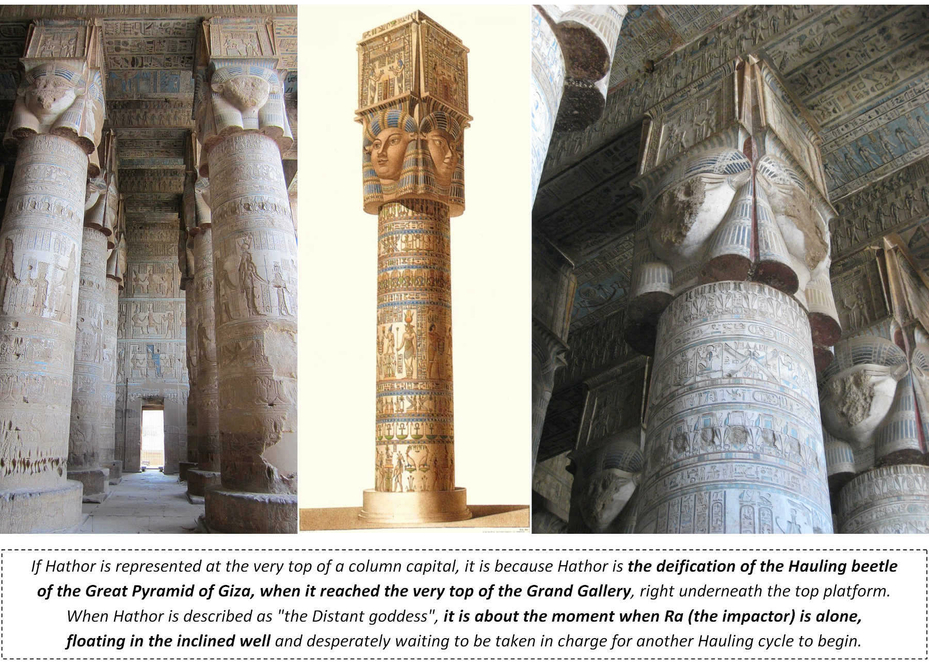
Hypostyle hall of the Temple of Hathor at Dendera, photographed by A. Parrot: https://en.wikipedia.org/wiki/Hathor#/media/File:Dendera_hypostyle_hall_crosswise.jpg
Hathor column at Dendera: https://upload.wikimedia.org/wikipedia/commons/7/75/Hathor_column_dendera.png
Hathor columns and breathtaking ceiling at Dendera, by Karen Green: https://www.flickr.com/photos/19479358@N00/4416542140
30.12 The Distant goddess Hathor
If Hathor is represented at the very top of a column capital, it is because Hathor is the deification of the Hauling beetle of the Great Pyramid of Giza, when it is back to the very top of the Grand Gallery, right underneath the top platform after having done its hauling job.
When Hathor is described as "the Distant goddess", it is about the moment when Ra (the impactor) is alone and floating in the inclined well, desperately waiting to be taken in charge for another Hauling cycle to begin.
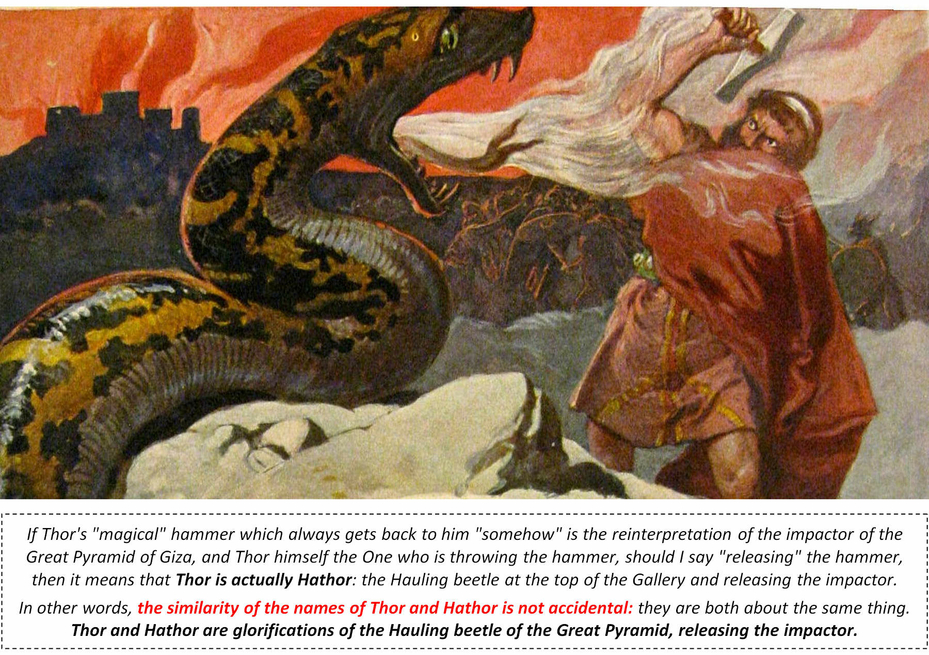
More on the total reinterpretation of the operation of the Great Pyramid of Egypt in the Norse mythology in Section 22 (the fog of cold, the well of Hvergelmir, the Great Hall of the largest building ever constructed...).
30.13 The similarity of the names of Thor and Hathor is not accidental: Thor really "is" Hathor (the Hauling beetle)
If Thor's "magical" hammer which always gets back to him "somehow" is the reinterpretation of the impactor of the Great Pyramid of Giza, and Thor himself the One who is throwing the hammer, should I say "releasing" the hammer, then it means that Thor is actually Hathor: the Hauling beetle at the top of the Gallery and releasing the impactor.
The similarity of the names of Thor and Hathor is not accidental: they are both about the same thing. Thor and Hathor are glorifications of the Hauling beetle of the Great Pyramid, releasing the impactor.
• Thor is endlessly throwing his "magical" hammer onto the Great Serpent Jörmungandr (into the water), and it comes back every time.
• Hathor is endlessly releasing her "magical" impactor onto the Great Serpent of the Underworld Apep (also into the primordial waters), and it comes back every time as well.
In other words: Thor = HaThor
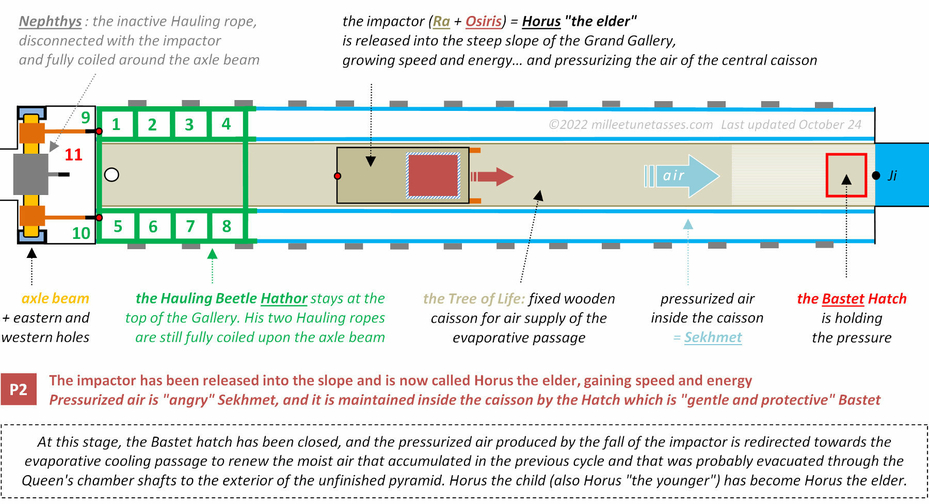
Of course, the impactor couldn't be seen inside the central wooden caisson; and the Hauling beetle is actually totally covering the caisson on both sides as well as on top: the central caisson also disappear completely underneath the Hauling beetle.
30.14 The operating cycle of the Grand Gallery • Position 2
The impactor has been released into the slope and is now called Horus the elder, gaining speed and energy. Pressurized air is "angry" Sekhmet, and it is maintained inside the caisson by the Hatch which is "gentle and protective" Bastet.
30.15 When Sobek is described as "the splashing one who came from the thigh and tail of the great goddess"
In the following excerpt, we have the description of the release of the impactor by Hathor. We've already seen that ancient Egyptians used sexual metaphors all around (the masturbatory hands of Atum, references to impregnation and copulation, etc.), and that all these metaphors were about the endless movements of the impactor through the wooden structure of the Hauling beetle that formed like a tunnel inside which the impactor kept "penetrating", or about the ejection of pressurized water from the well, consequently to this endless penetrating movement.
When Sobek is described as "green of plumage, with alert face and raised fore, the splashing one who came from the thigh and tail of the great goddess in the sunlight", it is precisely the description of the impactor release by Hathor. The "Great Goddess" is Hathor; the Beetle which was holding the impactor like a mother would do with her child, before releasing it.
"Unis is Sobek, green of plumage, with alert face and raised fore, the splashing one who came from the thigh and tail of the great goddess in the sunlight ... Unis has appeared as Sobek, Neith's son. Unis will eat with his mouth, Unis will urinate and Unis will copulate with his penis. Unis is lord of semen, who takes women from their husbands to the place Unis likes according to his heart's fancy". https://en.wikipedia.org/wiki/Sobek
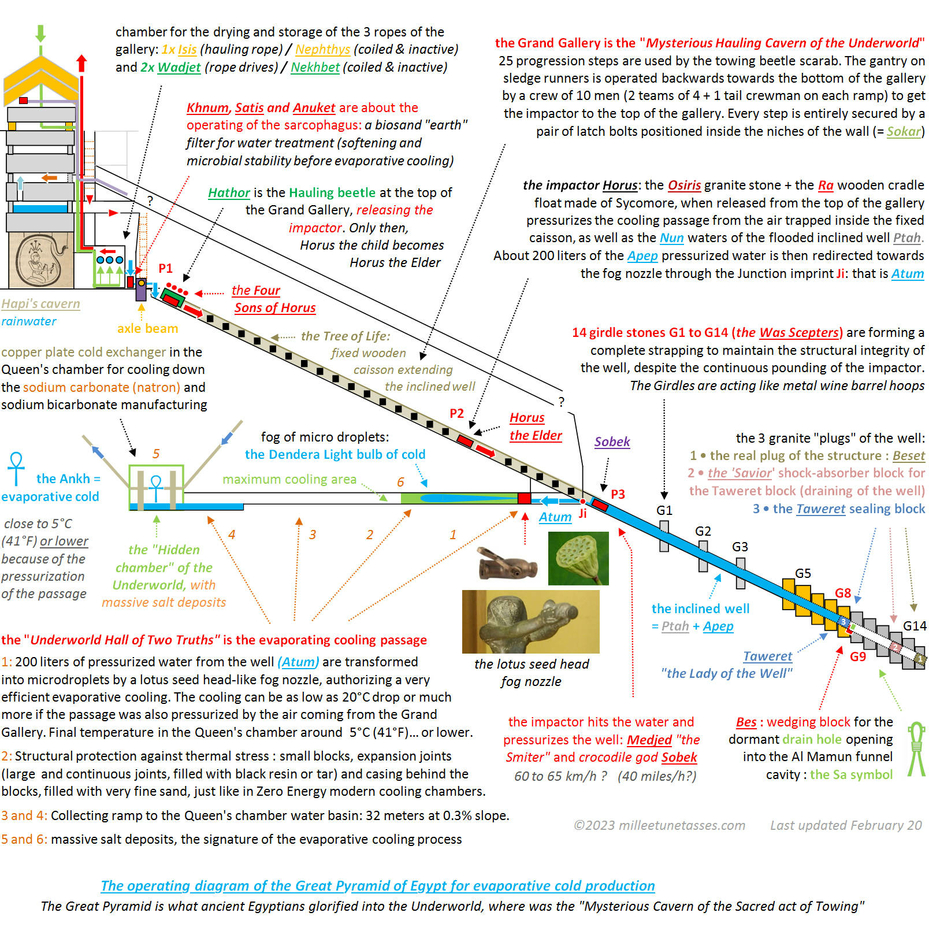
30.16 Operating diagram of the Great Pyramid of Egypt for Evaporative Cold production, using plain water
Last updated: February 17, 2023 (implementation of the Hauling beetle Hathor releasing the impactor, of the Four Sons of Horus crewmembers of the Beetle, of Medjed "the Smiter" as the impactor hitting the waters of the inclined well, and of Sobek as the impactor, more or less floating in the well after the impact). More on the Evaporative Cold process, in Section 1
Because each "Son of Horus" was actually representing a pair of crewmembers (the left arm and the right arm), there were 8 crewmembers in total, operating the Hauling beetle.
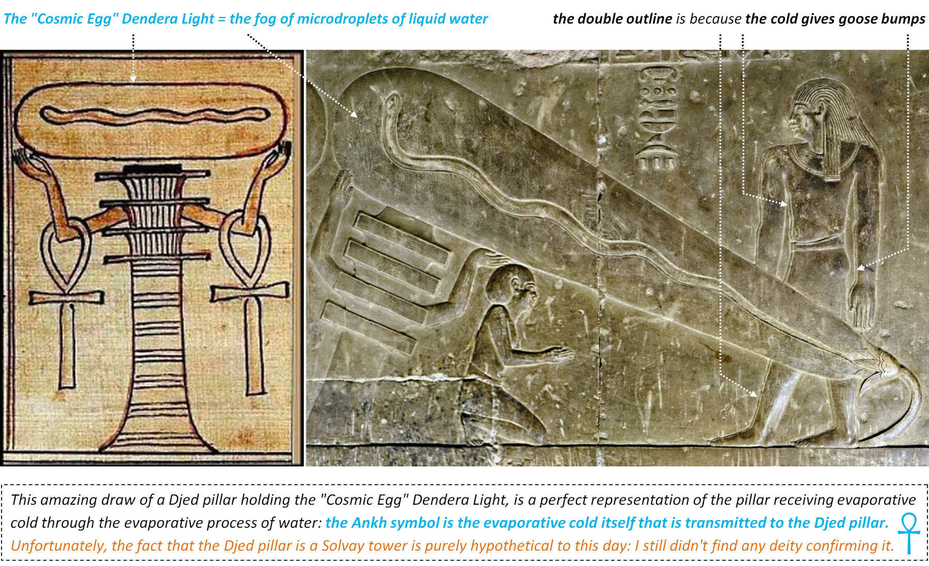
Relief of the Hathor temple at Dendera, showing the Dendera Light, photographed by Kairoinfo4U and posted on flickr: https://www.flickr.com/photos/manna4u/14525094039/in/photostream/
30.17 When "splashing" Sobek is involved in the process of Creation by laying "eggs" on the bank of Nun
This part of the mythology built on Sobek is crucial, because it directly links the "splashing" Sobek with the creation of the world process and the famous "eggs", which are here the exact same ones than the "cosmic egg" linked to the Dendera light.
The (numerous) "eggs" of Sobek are about the Dendera light and the (numerous) creation of fogs of microdroplets inside the evaporative cooling passage of the Great Pyramid.
"One creation myth stated that Sobek laid eggs on the bank of the waters of Nun, thus creating the world." https://ancientegyptonline.co.uk/sobek/
"One tale says that Sobek laid his eggs on the bank of the waters, starting the creation process." http://www.touregypt.net/featurestories/sobeka.htm

30.18 Family Tree of the major ancient Egyptian gods and goddesses
Ancient Egyptian gods were "only" metaphoric representations of the scientific knowledge and experimental accomplishments of the pharaohs. Most of them are directly referring to the Great Pyramid of Giza, the end game of hundreds of years of research.
30.19 Basic mathematics applied to Sobek reveal that Sobek = Horus = Ra
I really didn't expect that Sobek's study would be so prolific, but it turns out that he is maybe one of the most crucial gods of all, kind of at the heart of the abstract and metaphorical construction of what is the ancient Egyptian religion.
In the following excerpts, we can deduct that Sobek = Horus = Ra. It's what I've been saying all along, and it is right there:
1 • Sobek = Horus (Sobek fused with Horus)
"Amenemhat and many of his dynastic contemporaries engaged in building projects to promote Sobek – projects that were often executed in the Faiyum. In this period, Sobek also underwent an important change: he [Sobek] was often fused with the falcon-headed god of divine kingship, Horus. This brought Sobek even closer with the kings of Egypt, thereby giving him a place of greater prominence in the Egyptian pantheon". https://en.wikipedia.org/wiki/Sobek
2 • Sobek = Ra (Sobek fused with Ra)
"Sobek first acquired a role as a solar deity through his connection to Horus, but this was further strengthened in later periods with the emergence of Sobek-Ra, a fusion of Sobek and Egypt's primary sun god, Ra". https://en.wikipedia.org/wiki/Sobek
3 • If Sobek = Horus and Sobek = Ra, then Sobek = Horus = Ra
What needs to be pointed out, is that if the affirmation "Sobek = Horus" is 100% correct, the affirmation "Horus = Ra" is "only approximative", because Ra is not the glorification of the entire composite impactor, but only its wooden part. Though, if you just look at them, they are the same because only the wooden part is visible; the Osiris stone can't be seen.
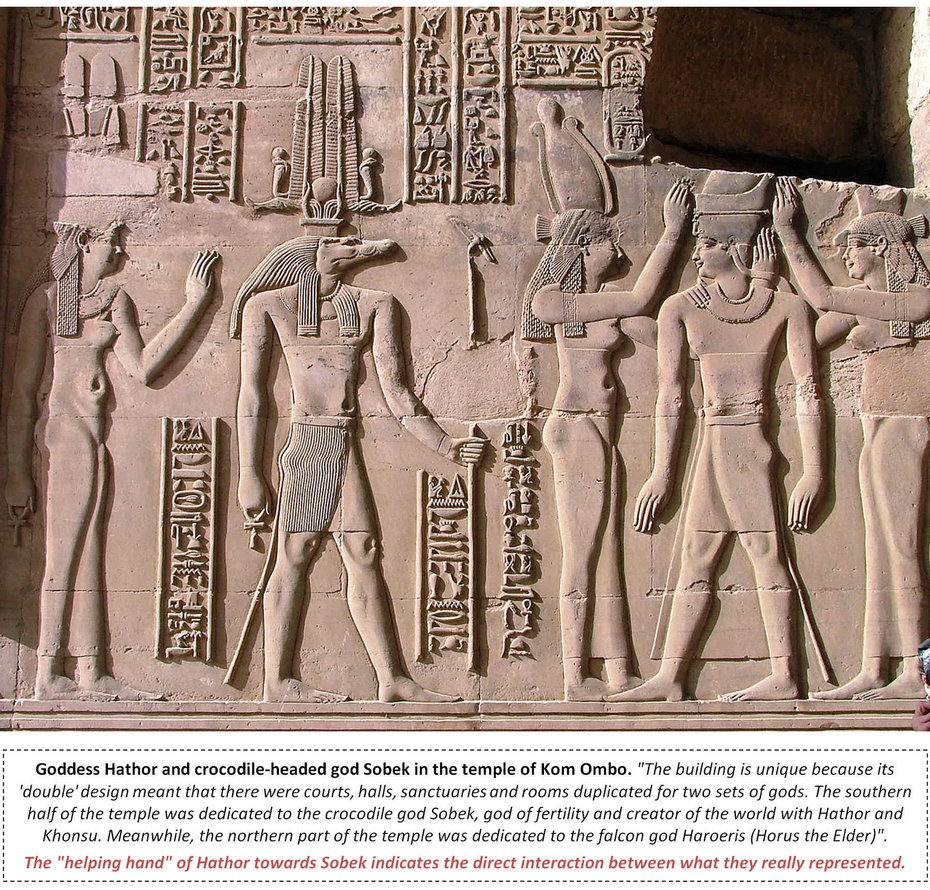
Goddess Hathor (left) and crocodile god Sobek, Temple of Kom Ombo, Egypt. Thanks to Codex: https://fr.m.wikipedia.org/wiki/Fichier:Kom-Ombo-Sobek-et-couronnement-001.jpg
30.20 The atypical temple of Kom Ombo isn't meant for two different deities, but just one single "god": the impactor of the Great Pyramid of Giza, worshiped at two different and consecutive stages of its operating cycle
The fact that Horus the Elder and Sobek were actually both about the same thing, the same "structure", i.e. the impactor getting inside the inclined well of the Great Pyramid, is explaining the unique "double" design for these two gods in the temple of Kom Ombo. The temple is also atypical because everything is perfectly symmetrical along the main axis.
In other words, the temple of Kom Ombo isn't really meant for two different gods, but for the same one: the impactor of the Great Pyramid of Giza, at two different but consecutive stages of its operating cycle.
"The building is unique because its 'double' design meant that there were courts, halls, sanctuaries and rooms duplicated for two sets of gods. The southern half of the temple was dedicated to the crocodile god Sobek, god of fertility and creator of the world with Hathor and Khonsu. Meanwhile, the northern part of the temple was dedicated to the falcon god Haroeris ("Horus the Elder"), along "with Tasenetnofret (the Good Sister, a special form of Hathor or Tefnet/Tefnut) and Panebtawy (Lord of the Two Lands)." The temple is atypical because everything is perfectly symmetrical along the main axis". https://en.wikipedia.org/wiki/Temple_of_Kom_Ombo
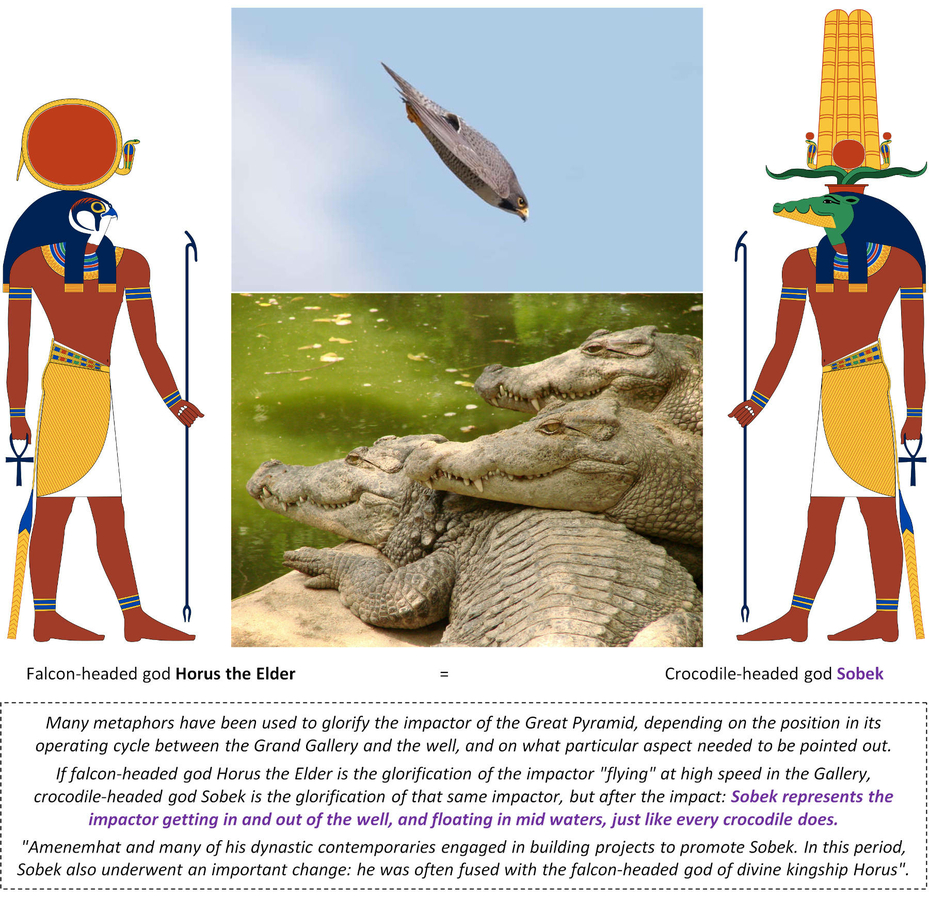
"Ra-Horakhty is a combined deity of Horus and Ra, and is usually depicted as a falcon-headed man wearing a sun disk on his head. By themselves, Ra and Horus sometimes share similar iconography". Wilkinson, Richard H. (2003), in "The complete gods and goddesses of ancient Egypt"; draw by Jeff Dahl: https://en.wikipedia.org/wiki/Ra#/media/File:Re-Horakhty.svg
"Sobek, an ancient Egyptian crocodile god, often depicted with a crown composed of ram horns, a sun disk, and feathered plumes". Draw by Jeff Dahl: https://en.wikipedia.org/wiki/Sobek#/media/File:Sobek.svg
30.21 No trace of Sobek at the time when the Great Pyramid was built (Fourth Dynasty)
One of the most difficult things about the deciphering of the real ancient Egyptian history, is the fact that the study has to concentrate both on very little details (architecture particularities, artifact designs and all kind of mythological details), but also on the widest spectrum of the Egyptian history known today.
It is only when you step back at the whole picture that maybe the most important data are visible; and what we know of Sobek is very revealing of the major role that took the Fourth Dynasty: there is simply no trace of Sobek before the Fifth Dynasty.
Nor there is no trace of many other ancient Egyptian gods and goddesses; actually, the "Pyramid Texts" so often mentioned by egyptologists, first appear during that particular Fifth Dynasty; there is nothing before. It means that during the historical period when the great pyramids of Djoser, Sneferu, Khufu and Khafre, pretty much no major "religious" text has ever been written when at the same time, hundreds of thousands of people built these pyramids (and mastabas) over about 656 years. (3150 BCE for the beginning of the First Dynasty to 2494 BCE for the end of the Fourth Dynasty).
What I'm saying, is that it is the Great Pyramid who triggered and inspired all these Pyramid Texts.
https://en.wikipedia.org/wiki/Dynasties_of_ancient_Egypt
"Sobek (also known as Sebek, Sebek-Ra, Sobeq, Suchos, Sobki, and Soknopais) was the ancient god of crocodiles. He is first mentioned in the Pyramid Texts and his worship continued until the Roman period". https://ancientegyptonline.co.uk/sobek/
"Sobek enjoyed a longstanding presence in the ancient Egyptian pantheon, from the Old Kingdom of Egypt (c. 2686–2181 BCE) through the Roman period (c. 30 bce–350 ce ). He is first known from several different Pyramid Texts of the Old Kingdom, particularly from spell PT 317. The spell, which praises the pharaoh as the living incarnation of the crocodile god, reads: Unis is Sobek, green of plumage, with alert face and raised fore, the splashing one who came from the thigh and tail of the great goddess in the sunlight ... Unis has appeared as Sobek, Neith's son. Unis will eat with his mouth, Unis will urinate and Unis will copulate with his penis. Unis is lord of semen, who takes women from their husbands to the place Unis likes according to his heart's fancy". https://en.wikipedia.org/wiki/Sobek
"The Pyramid Texts are a collection of funerary inscriptions written on the walls of nine Fifth and Sixth Dynasty pyramids (generally dated to around 2350 B.C.E)". https://ancientegyptonline.co.uk/pyramidtext/
"The Pyramid Texts are the oldest ancient Egyptian funerary texts, dating to the late Old Kingdom. They are the earliest known corpus of ancient Egyptian religious texts. Written in Old Egyptian, the pyramid texts were carved onto the subterranean walls and sarcophagi of pyramids at Saqqara from the end of the Fifth Dynasty, and throughout the Sixth Dynasty of the Old Kingdom, and into the Eighth Dynasty of the First Intermediate Period. The oldest of the texts have been dated to c. 2400–2300 BCE". https://en.wikipedia.org/wiki/Pyramid_Texts
Poster un commentaire

